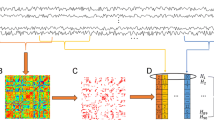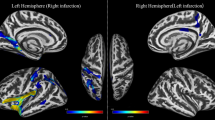Abstract
Moyamoya disease (MMD) is a cerebrovascular disease that is characterized by progressive stenosis or occlusion of the internal carotid arteries and its main branches, which leads to the formation of abnormal small collateral vessels. However, little is known about how these special vascular structures affect cortical network connectivity and brain function. By applying EEG analysis and graphic network analyses undergoing EEG recording of subjects with eyes-closed (EC) and eyes-open (EO) resting states, and working memory (WM) tasks, we examined the brain network features of hemorrhagic (HMMD) and ischemic MMD (IMMD) brains. For the first time, we observed that IMMD had the much lower alpha-blocking rate during EO state than healthy controls while HMMD exhibited the relatively low EEG activity rate across all the behavior states. Further, IMMD showed strong network connections in the alpha-wave band in frontal and parietal regions during EO and WM states. EEG frequency and network topological maps during both resting and WM states indicated that the left frontal lobe and left parietal lobe in HMMD patients and the right parietal lobe and temporal lobe in IMMD patients have clear differences compared with controls, which provides a new insight to understand distinct electrophysiological features of MMD. However, due to the small sample size of recruited patient subjects, the result conclusion may be limited.





Similar content being viewed by others
Data availability
EEG data collected in patients in this paper are owned by Huashan Hospital, Fudan University. If you have any questions about the authenticity of the data, you can contact the corresponding author by email.
References
Achard S, Bullmore E (2007) Efficiency and cost of economical brain functional networks. PLoS Comput Biol 3(2):e17
Baldy-Moulinier M, Ingvar DH (1968) EEG frequency content related to regional blood flow of cerebral cortex in cat. Exp Brain Res 5(1):55–60
Bullmore E, Sporns O (2009) Complex brain networks: graph theoretical analysis of structural and functional systems. Nat Rev Neurosci 10(3):186
Bullmore E, Sporns O (2012) The economy of brain network organization. Nat Rev Neurosci 13(5):336
Cho A, Chae J-H, Kim HM et al (2014) Electroencephalography in pediatric moyamoya disease: reappraisal of clinical value. Child’s Nervous Syst 30(3):449–459
Chotas H, Bourne J, Teschan P (1979) Heuristic techniques in the quantification of the electroencephalogram in renal failure. Comput Biomed Res 12(4):299–312
de Oliveira JL, Ávila M, Martins TC et al (2020) Medium- and long-term functional behavior evaluations in an experimental focal ischemic stroke mouse model. Cogn Neurodynamics 14(4):473–481
Delorme A, Makeig S (2004) EEGLAB: an open source toolbox for analysis of single-trial EEG dynamics including independent component analysis. J Neurosci Methods 134(1):9–21
Frechette E, Bell-Stephens T, Steinberg G, Fisher R (2015) Electroencephalographic features of moyamoya in adults. Clin Neurophysiol 126(3):481–485
Honey CJ, Kötter R, Breakspear M, Sporns O (2007) Network structure of cerebral cortex shapes functional connectivity on multiple time scales. Proc Natl Acad Sci 104(24):10240–10245
Humphries MD, Gurney K, Prescott TJ (2006) The brainstem reticular formation is a small-world, not scale-free, network. Proce Royal Soci London B: Biol Sci 273(1585):503–511
Ingvar DH (1971) Cerebral blood flow and metabolism related to EEG and cerebral functions. Acta Anaesthesiol Scand 15:110–114
Ingvar DH, Sjölund B, Ardö A (1976) Correlation between dominant EEG frequency, cerebral oxygen uptake and blood flow. Electroencephalogr Clin Neurophysiol 41(3):268–276
Jonkman E, Van Dieren A, Veering M, Ponsen L, Da Silva FL, Tulleken C. 1984 EEG and CBF in cerebral ischemia. Follow-up studies in humans and monkeys. Progress in brain research. Elsevier, Amsterdam
Jortner RA, Farivar SS, Laurent G (2007) A simple connectivity scheme for sparse coding in an olfactory system. J Neurosci 27(7):1659–1669
Kaiser DA (2005) Basic principles of quantitative EEG. J Adult Dev 12(2–3):99–104
Karzmark P, Zeifert PD, Bell-Stephens TE, Steinberg GK, Dorfman LJ (2011) Neurocognitive impairment in adults with moyamoya disease without stroke. Neurosurgery 70(3):634–638
Kazumata K, Tha KK, Narita H, et al. Chronic ischemia alters brain microstructural integrity and cognitive performance in adult moyamoya disease. Stroke 2014: STROKEAHA. 114.007407.
Kazumata K, Tha KK, Narita H et al (2016) Investigating brain network characteristics interrupted by covert white matter injury in patients with moyamoya disease: insights from graph theoretical analysis. World Neurosurg 89(654–65):e2
Kim JE, Jeon JS (2014) An update on the diagnosis and treatment of adult moyamoya disease taking into consideration controversial issues. Neurol Res 36(5):407–416
Kodama N, Aoki Y, Hiraga H, Wada T, Suzuki J (1979) Electroencephalographic findings in children with moyamoya disease. Arch Neurol 36(1):16–19
Koessler L, Maillard L, Benhadid A et al (2009) Automated cortical projection of EEG sensors: anatomical correlation via the international 10–10 system. Neuroimage 46(1):64–72
Kuroda S, Houkin K (2008) Moyamoya disease: current concepts and future perspectives. The Lancet Neurology 7(11):1056–1066
Lei Y, Li Y, Ni W et al (2014) Spontaneous brain activity in adult patients with moyamoya disease: a resting-state fMRI study. Brain Res 1546:27–33
Lei Y, Song B, Chen L et al (2018) Reconfigured functional network dynamics in adult moyamoya disease: a resting-state fMRI study. Brain Imaging Behav 14:1–13
Liu Y, Liang M, Zhou Y et al (2008) Disrupted small-world networks in schizophrenia. Brain 131(4):945–961
Marek S, Dosenbach NU (2018) The frontoparietal network: function, electrophysiology, and importance of individual precision mapping. Dialogues Clin Neurosci 20(2):133
Mognon A, Jovicich J, Bruzzone L, Buiatti M (2011) ADJUST: An automatic EEG artifact detector based on the joint use of spatial and temporal features. Psychophysiology 48(2):229–240
Nagata K (1989) Topographic EEG mapping in cerebrovascular disease. Brain Topogr 2(1–2):119–128
Niedermeyer E (1997) Alpha rhythms as physiological and abnormal phenomena. Int J Psychophysiol 26(1–3):31–49
Niedermeyer E (2003) The clinical relevance of EEG interpretation. Clin Electroencephalogr 34(3):93–98
Olshausen BA, Field DJ (1996) Emergence of simple-cell receptive field properties by learning a sparse code for natural images. Nature 381(6583):607
Onnela J-P, Chakraborti A, Kaski K, Kertiész J (2002) Dynamic asset trees and portfolio analysis. Europ Phys J B-Condensed Mat and Complex Syst 30(3):285–288
Pfurtscheller G (2001) Functional brain imaging based on ERD/ERS. Vision Res 41(10–11):1257–1260
Rubinov M, Sporns O (2010) Complex network measures of brain connectivity: uses and interpretations. NeuroImage 52(3):1059–1069
Scott RM, Smith ER (2009) Moyamoya disease and moyamoya syndrome. N Engl J Med 360(12):1226–1237
Simoncelli EP, Olshausen BA (2001) Natural image statistics and neural representation. Annu Rev Neurosci 24(1):1193–1216
Stam CJ, Nolte G, Daffertshofer A (2007) Phase lag index: assessment of functional connectivity from multi channel EEG and MEG with diminished bias from common sources. Hum Brain Mapp 28(11):1178–1193
Stam C, De Haan W, Daffertshofer A et al (2008) Graph theoretical analysis of magnetoencephalographic functional connectivity in Alzheimer’s disease. Brain 132(1):213–224
Su SH, Hai J, Zhang L, Yu F, Wu YF (2013) Assessment of cognitive function in adult patients with hemorrhagic moyamoya disease who received no surgical revascularization. Eur J Neurol 20(7):1081–1087
Sulg IA. The quantitated EEG as a measure of brain dysfunction: A study by means of manual analysis of the electroencephalogram (EEG): Department of Clinical Neurophysiology, University Hospital Lund; 1969.
Suzuki J, Takaku A (1969) Cerebrovascular moyamoya disease: disease showing abnormal net-like vessels in base of brain. Arch Neurol 20(3):288–299
Tolonen U, Ahonen A, Sulg I et al (1981) Serial measurements of quantitative EEG and cerebral blood flow and circulation time after brain infarction. Acta Neurol Scand 63(3):145–155
Vinje WE, Gallant JL (2000) Sparse coding and decorrelation in primary visual cortex during natural vision. Science 287(5456):1273–1276
Wan L, Huang H, Schwab N et al (2018) From eyes-closed to eyes-open: role of cholinergic projections in EC-to-EO alpha reactivity revealed by combining EEG and MRI. Human Brain Map 40:566–577
Watts DJ, Strogatz SH (1998) Collective ynamics of ‘small-world’networks. Nature 393(6684):440–442
Xie P, Pang X, Cheng S et al (2020) Cross-frequency and iso-frequency estimation of functional corticomuscular coupling after stroke. Cogn Neurodynamics. https://doi.org/10.1007/s11571-020-09635-0.
Yu Y, Migliore M, Hines ML, Shepherd GM (2014) Sparse coding and lateral inhibition arising from balanced and unbalanced dendrodendritic excitation and inhibition. J Neurosci 34(41):13701–13713
Yu M, Gouw AA, Hillebrand A et al (2016) Different functional connectivity and network topology in behavioral variant of frontotemporal dementia and Alzheimer’s disease: an EEG study. Neurobiol Aging 42:150–162
Zeng K, Kang J, Ouyang G et al (2017) Disrupted brain network in children with autism spectrum disorder. Sci Rep 7(1):16253
Zhang J, Wang J, Wu Q et al (2011) Disrupted brain connectivity networks in drug-naive, first-episode major depressive disorder. Biol Psychiat 70(4):334–342
Acknowledgements
This study was supported by the National Natural Science Foundation of China (81761128011, 81801155, and 81771237), Shanghai Science and Technology Committee support (16JC1420100, 18511102800), Shanghai Health and Family Planning Commission support (2017BR022), the program for the Professor of Special Appointment (Eastern Scholar) at Shanghai Institutions of Higher Learning, the “Dawn” Program of Shanghai Education Commission (16SG02), and the Scientific Research Project of Huashan Hospital, Fudan University (2016QD082), the Shanghai Municipal Science and Technology Major Project (No. 2018SHZDZX01) and ZJLab, the program for the Professor of Special Appointment (Eastern Scholar) at Shanghai Institutions of Higher Learning.
Author information
Authors and Affiliations
Contributions
YY, YG and YM supervised the research, YL, GZ and YY designed the research, GZ, YL, YL, WZ, JS, XQ, LC and XZ performed the research, and GZ, YL and YY wrote the paper. All authors reviewed the manuscript.
Corresponding authors
Ethics declarations
Conflict of interest
The authors declare no conflict of interests.
Ethical approval
This study was approved and supervised by the Ethics Committee of Huashan Hospital.
Informed consent
All participants signed written informed consent.
Additional information
Publisher's Note
Springer Nature remains neutral with regard to jurisdictional claims in published maps and institutional affiliations.
Supplementary information
Rights and permissions
About this article
Cite this article
Zheng, G., Lei, Y., Li, Y. et al. Changes in Brain Functional Network Connectivity in Adult Moyamoya Diseases. Cogn Neurodyn 15, 861–872 (2021). https://doi.org/10.1007/s11571-021-09666-1
Received:
Revised:
Accepted:
Published:
Issue Date:
DOI: https://doi.org/10.1007/s11571-021-09666-1




